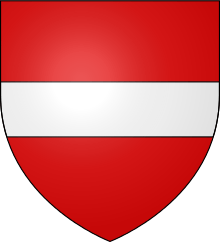Counts of Louvain
The Counts of Louvain were a branch of the Lotharingian House of Reginar which from the late 10th century ruled over the estates of Louvain (French) or Leuven (Dutch) in Lower Lorraine.

History
The Reginar count Gilbert of the Maasgau, a vassal of the West Frankish king Charles the Bald, had married a daughter of the Carolingian emperor Lothair I in 846; his son Reginar ruled over the Duchy of Lorraine (Lotharingia) from 910 to 915. His son and successor Gilbert swore fealty to the East Frankish king Henry the Fowler in 925 and three years later married his daughter Gerberga of Saxony. His younger brother Reginar attained the title of a Count of Hainaut.
About 990 Lambert the Bearded (d. 1015), grandson of Count Reginar II, married Gerberga, daughter of the Carolingian duke Charles of Lower Lorraine, and in 994 was vested with the title of Count of Louvain. Originally limited by the rivers Demer, Dijle and Velp, that is more or less the region known today as Hageland, his county rapidly increased in size and power. Lambert I incorporated the County of Brussels and in 1013 annexed the Duchy of Bruningrode, located around Tongeren.
By Lambert's marriage, the Reginar counts claimed the Lorraine ducal title and over the decades acquired great influence in the Holy Roman Empire, acquiring more comital titles over time. His son Lambert II is also mentioned as a count of Brussels, where he had the St. Michael's Church erected to house the relics of Saint Gudula. When he joined the rebellion of Count Baldwin V of Flanders against Emperor Henry III, he was killed in a 1054 battle at Tournai.
His grandson, Count Henry III of Louvain was vested with the title of a Landgrave of Brabant upon the death of the Ezzonid count palatine Hermann II of Lotharingia in 1085. He was succeeded by his brother Godfrey I, who retained the landgravial title and 1106 even was raised to a Duke of Lower Lorraine; nevertheless, he had to cede the ducal title to Count Waleran III of Limburg in 1128.
In 1139 Godfrey's son Count Godfrey II was again appointed Duke of Lower Lorraine by King Conrad III of Germany and also received the Margraviate of Antwerp. He prevailed against Waleran's son Duke Henry II of Limburg; both noble houses reconciled with the marriage of Count Godfrey III of Louvain and Henry's daughter Margaret. In 1183, he had his son Henry elevated to the rank of Duke of Brabant by Emperor Frederick Barbarossa and the County of Louvain was absorbed into the newly created Duchy of Brabant.
Counts of Louvain and Brussels
- 1003–1015: Lambert I, was the first Count of Louvain, son of Reginar III Count of Hainaut
- 1015–1038: Henry I, (son of Lambert I)
- 1038–1040: Otto
- 1040–1054: Lambert II, (son of Lambert I)
- 1054–1079: Henry II, (son of Lambert II)
- 1079–1086: Henry III, (son of Henry II)
Counts of Louvain and Brussels, Landgraves of Brabant
Counts of Louvain and Brussels, Landgraves of Brabant, Dukes of Lower-Lorraine
- 1106–1128: Godfrey I, (son of Henry II)
- 1128–1141: Godfrey II, (son of Godfrey I)
- 1141–1190: Godfrey III, (son of Godrey II)
From 1183 onwards the titles of Count of Louvain, Count of Brussels and Landgrave of Brabant were merged in the title of Duke of Brabant and used as appanages.